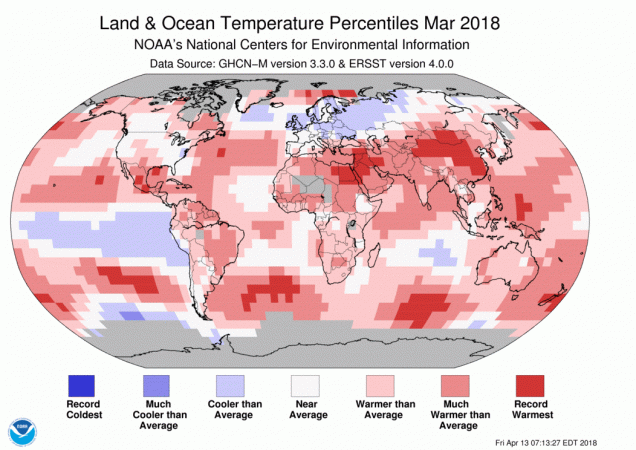At a time when major US cities, London and Tokyo are witnessing extreme heat waves, the National Oceanic and Atmospheric Administration (NOAA) has reported that the year 2018 will emerge as the fourth hottest year on record, behind 2015, 2016 and 2017.
As climate change is triggering extreme weather -- from excessive rains, harsh, bitter winters, to unbearably hot summers, overall temperatures are also slowly rising and have reached record highs in the last four years.
This upward trend, notes a report by CNN, is a clear indication of global warming, say experts. It is a serious cause for concern, because of the consistent rise in global temperatures and this is one of the best indicators of climate change, even more so than the extreme droughts and floods happening simultaneously all over the world.

Any one region can have high and low temperatures throughout the course of one day, but the warming of the entire planet is measured by observing climate patterns spread all over the planet. "The impacts of climate change are no longer subtle," said Michael Mann, climate scientist and director of the Earth System Science Center at Penn State University.
"We are seeing them play out in real time in the form of unprecedented heat waves, floods, droughts and wildfires. And we've seen them all this summer," he said.
Of the many causes of climate change, trapping of greenhouse gases like carbon dioxide in the Earth's atmosphere is still the most destructive, notes the report. This dumping of carbon dioxide is further made worse by human industrialization by locking in heat in oceans as well as over land which raises temperatures all over the planet, notes the report.
NOAA report said only three other years have been hotter than 2018 so far- 2015, 2016 and 2017, demonstrating how the first two quarters of 2018 can be termed "warmer" to "much-warmer-than-average" temperatures across the Earth- both in terms of ocean and land surfaces.
Record heat was observed over the Mediterranean region, areas across North America, all the way down to Asia, Australia and New Zealand.
On the other side of the equation, there was no part of the world, land or water that had record low or cold temperatures, anywhere in the world in the same January to June time period this year.
In a map released by NOAA displaying global temperatures are consistently in the red or pink. Red shows heat, blue shows cold.

Majority of the planet has at least been warmer-than-average so far this year, leaving aside only a small percentage of the locations below average. The one large swathe of ocean near the Pacific is shown to have below average temperature, that part of the ocean is explained by the report as a result of La Niña—cyclical cooling of the equatorial Pacific Ocean. La Niña is expected to cool the planet a lot more than what has happened so far this year, say reports.
On the whole, both land and ocean surfaces are as of now 0.77 degrees Celsius higher than 20 century average, says the report. The hottest year ever on record was 2016, it was followed by 2015 and 2017, while 2018 is on the way to becoming the fourth hottest year ever.

"...Today, climate change is loading the dice against us, making certain types of extremes, such as heat waves and heavy rain events, much more frequent and more intense than they used to be," said Katharine Hayhoe, a climate scientist at Texas Tech University.















